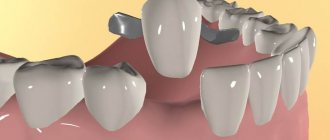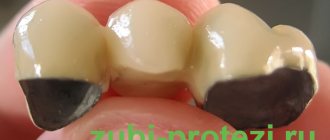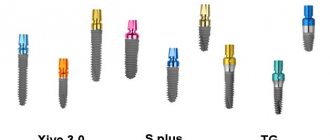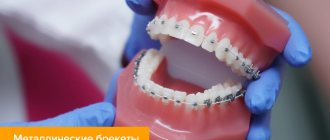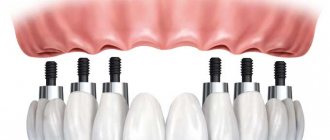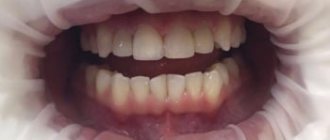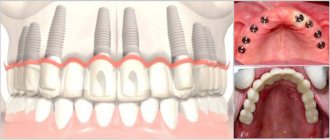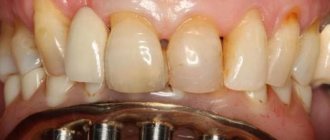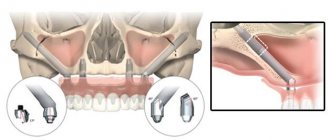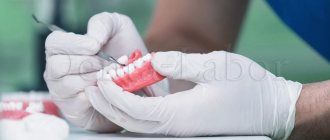Modern solutions offered by clinics allow an individual approach to each patient and selection of the optimal method of restoring teeth in case of their destruction or absence. Prosthetics allows you to restore the aesthetics of the dentition and natural chewing functions, while prolonged absence of teeth always leads to serious health consequences - it affects the bite, jaw joints, and facial appearance. Therefore, it is so important to undergo prosthetics as soon as possible and enjoy the result. But what if instead of “pleasure” you get pain after dental prosthetics?
Dental bridges
- Work examples
- Questions and answers
- Stock
- Reviews
- Kinds
- Materials
- Advantages and disadvantages
Dental bridges are permanent structures used as an alternative to implants in cases where it is necessary to restore from 1 to 4 adjacent units in the dentition. As the name suggests, this prosthesis really looks like a bridge. It has two supports - most often these are crowns that are put on your own teeth - and artificial ones are located between them. Among the main advantages of the technology: excellent aesthetics and a high level of restoration of chewing function.
Prevention
Often people themselves provoke the development of the disease. It is enough to follow the dentist’s recommendations, which he gives after installing an artificial structure, and follow some rules.
- Carry out minimal denture care: brush your teeth twice a day, rinse your mouth after meals. There are special means for this.
- Folk remedies. Herbal decoctions are perfect for sanitizing the oral cavity.
- Tongue brushes. With their help, it will be possible to reduce the number of microbes and prevent them from getting under the prosthesis.
- Use an irrigator. This is a device for cleaning teeth from food debris in hard-to-reach places. Where the toothbrush does not reach, food remains; over time, microbes appear there, multiply and infect the tooth. An irrigator helps clean such areas.
- Dentist examination. Timely periodic visits to the dental office are the main method of prevention. A specialist can identify the initial stage of the disease. Treatment will then be quick and without complications.
You can prevent pain under your denture. After all, the cause of inflammation is not always a medical error.
What you will have to face at the beginning
Of course, dentures help solve many problems, but at the same time, they give rise to many new problems. And no wonder, because a foreign object in the oral cavity, which, in fact, is a denture, causes a normal defensive reaction of the body - irritation, rejection, etc.
One of these problems is the difficulty of getting used to dentures.
- Gagging . The gag reflex is a normal reaction of the body to the penetration of an object that is not food into the oral cavity.
- Profuse salivation . If the body “perceives” an object in the mouth as food, the brain gives a signal to turn on the corresponding functions - saliva begins to be released, which is necessary to facilitate the penetration of food into the throat, and gastric juice is secreted.
- Speech and diction disorders . “New teeth” are not always a complete copy of the original ones; it takes time to “reconfigure” articulation when speaking. In addition, dentures often “interfere” with the tongue, which constantly “clings” to them, which also does not contribute to intelligible speech.
- Discomfort when chewing . It occurs especially often when using removable dentures, including clasp dentures. This is due to the fact that the distribution of loads when chewing with removable dentures may differ from natural.
- Partial loss of taste . The fact is that not only the tongue takes part in the formation of the sensation of taste. The sensation of taste is indirectly affected by the mucous membranes of the oral cavity, some of which may be hidden under the prosthesis.
Symptoms of gum inflammation under the crown
Unpleasant sensations may appear a long time after the bridge is installed. The development of the pathological process can be determined by obvious signs:
- pain - can only occur with pressure or be constant;
- swelling – the gums around the crown swell, causing discomfort;
- bleeding;
- shooting pain in the ear;
- bad breath;
- temperature increase.
If the inflammatory process is not stopped, the consequences will be serious, the symptoms will be more pronounced.
Symptom
Characteristic
How long does it take to get used to dentures?
According to experts and implantologists, adaptation to fixed structures is much easier. To answer the question of what period of adaptation is considered normal, it is necessary to take into account several factors: the characteristics of the oral cavity, the absence/presence of dental diseases and pathologies, the age of the patient, and the type of design. The question of how to quickly get used to dentures is rarely asked by patients who have had a crown or prosthesis installed on a pin, as well as an implant.
Even if several artificial structures appear in the oral cavity, adaptation to them occurs in a matter of days. It will take a little more time to get used to the so-called “bridges” - bridge-like prostheses.
The longest period of adaptation belongs to removable structures - dentures made of acrylic or nylon, clasp dentures containing metal. Here, the adaptation period consists of several conditions. How long it takes to get used to dentures depends on the following factors:
- product size;
- way of distributing the load during chewing;
- method of fixing the structure in the oral cavity;
- individual characteristics of the structure of the oral cavity, reactions to a foreign body.
How to quickly get used to removable dentures? Most experts are unanimous in their opinion - in the first month after installation of the structure, you do not need to remove it at night, this way you can reduce the adaptation period of the tissues. However, we must not forget about hygiene - the prosthesis must be regularly cleaned of plaque. To speed up addiction, you can use other advice from doctors.
Diagnostics
To diagnose inflammation and find out the cause that provoked it, the following diagnostic procedures are prescribed:
- External examination of the tooth. The doctor visually examines the tooth and assesses its condition - is there swelling, is the gum bleeding, is the crown loose, and the gums are palpated for tumor. With such a study, the doctor can see fistulas and ulcers, evaluate the correctness of the crown in the place where it mates with the gum, but to find out the root cause of the pathology, a hardware examination is needed.
- X-ray. In the picture you can see the depth of spread of the infectious process, the affected area, and the presence of a foreign object in the dental cavity. In addition, you can determine the quality of the filling, as well as how tightly the material adheres to the cavity. All this information allows the specialist to draw up the correct treatment plan and outline a path to access the area where the infection is developing.
- In some cases, a computed tomography scan is prescribed.
If the inflammatory process has developed under the prosthesis, then dental treatment can be carried out in two ways - with complete removal of the crown, or without removing it.
Dental intervention
If there is caries, pulpitis or periodontitis under the crown, most often a hole is made in the tooth through which the inflamed nerve is removed or the damaged cavity is sanitized. Then the doctor puts the medicine into the cavity and seals it.
If there is a pin structure in the root canal, the apex of the root is cut off. This is a simple operation involving cutting into the gums. Through this incision the source of the inflammatory process is eliminated.
In case of severe inflammation, the denture is removed and the diseased tooth is removed. After tooth extraction, treatment should continue for another couple of months until the inflammatory process subsides completely. Only after this, and if the patient does not experience pain, can the crown be reinstalled.
If pain occurs under the crown, you must urgently consult a dentist; self-medication and dulling the pain with painkillers can only worsen the situation.
Treatment at home
If a visit to the dentist is impossible for any reason as soon as possible, acute pain can be relieved with the help of painkillers.
Before taking any product, you must carefully read the instructions. Most painkillers are prohibited from taking more than 3 tablets per day.
If the pain is not very severe, you can take:
- Paracetamol;
- Analgin;
- Aspirin;
- Efferalgan.
Paracetamol
For very severe pain, it is recommended:
The listed remedies eliminate pain, but do not fight the inflammatory process, therefore, the pain will subside, but the inflammation will progress.
Anti-inflammatory drugs can only be prescribed by the attending physician, who will assess the condition of the root and surrounding tissues based on x-rays. If there is no inflammation in the tissues, rinsing is prescribed:
Read also: How to relieve gum swelling at home
Anti-inflammatory ointments may be prescribed:
- Metrogil Denta;
- gentamicin ointment;
- Solcoseryl;
- Holisal.
In case of complications, antibacterial drugs are prescribed. For purulent processes, Amoxiclav and Amoxicillin are used.
Traditional methods of treating the inflammatory process under the dental crown can only be used in the presence of primary drug treatment, that is, as additional therapy.
Traditional medicine can relieve pain and somewhat reduce the amount of pathogenic microflora that is involved in the inflammatory process, however, they cannot completely cure inflammation.
Aloe juice . If you cut a piece of a leaf of this plant, remove the skin from it and apply it to the sore spot, the pain will go away. You may feel a burning sensation at first, but this sensation goes away pretty quickly.
Aloe juice has a very bitter taste, and the aftertaste persists for a couple of hours after removing the medicinal plant from the oral cavity.
Sage and chamomile . This product is used for baths and rinsing. A tablespoon of herbal mixture is poured into a glass of boiling water, infused for about an hour, and then used warm. To make an analgesic and anti-inflammatory bath, the product must be taken into the mouth and held for 5 minutes on the inflammation side.
Oak bark . This remedy is brewed in the same way as the previous one and used to rinse the mouth.
Soda-salt solution . The usual preparation is that you will need one teaspoon of each product per glass of water. The product is thoroughly stirred and cooled. It is necessary to rinse after every meal.
Digital Computer Dentistry in Kharkov – high quality at the best prices
Today our clinic has a full range of robotic dental production. This allows us to provide the highest quality work for our patients at low prices. We manufacture crowns, bridges and screw-retained prostheses in a digital protocol using CAD/CAM technology. This increases patient comfort and eliminates technical human errors. Therefore, we are constantly introducing digital technologies, promoting digital services and explaining what this means.
4 Best Dental Implant Options That Will Ensure Success
Description of treatment and prices for implantation USA, Israel, Germany.
Complications
If the gums become inflamed and treatment is not carried out, serious complications are possible. In addition, such a manifestation may indicate more serious health problems than pulpitis or periodontitis.
Redness of the tissues and their swelling under the denture indicate pathologies that occur deep in the jaw. If the problem spreads to a healthy tooth, it will be rejected and will need to be removed in the future.
After dentures, careful oral care is necessary to significantly reduce the possibility of inflammatory processes and other complications. Typically, dentists advise their patients the following:
- At least 2 times a day, brush your teeth and rinse the entire mouth to remove plaque that appears during the day. To do this, use a regular toothbrush, toothpastes, as well as rinses and tooth powders.
- It is recommended to remove dentures before going to bed. This action allows the gums to rest. The prosthesis should be placed overnight in a solution made on the basis of medicines; this will preserve its appearance and period of operation.
- As an additional cleaning of the mouth, decoctions or infusions of herbs are used, which are easy to buy at the pharmacy and prepare at home.
- To prevent tissues and mucous membranes from rejecting the prosthesis in the mouth, it is recommended to carry out massages. To do this, gently knead the gums with your fingers, which improves blood circulation and also removes swelling. Massage allows you to relieve pain syndromes.
- You need to brush your teeth vigorously, especially in the crevices between the teeth. Due to this, there will be no food left between the denture and the gum, which will begin to rot over time. This will not only prevent an unpleasant odor, but also bacteria will not develop and inflammatory processes will not occur.
If you follow the care tips, everything should be fine, but if the problem persists, you should go see a doctor.
Cost of dental implants and bridges
The cost of a bridge depends on the material from which it is made, the cheapest is made of plastic, the most expensive is made of solid ceramics. The metal-ceramic design is considered optimal in terms of price. The cost of the service for installing a bridge includes taking impressions, processing the supporting teeth, making the prosthesis and fixing it.
The price of an implant depends on the manufacturer, the purity of the alloy and the presence of a coating that speeds up the healing process. Of the crowns on implants, the most expensive are zirconium and ceramic.
The method of fastening determines the first important criterion in the debate “which is better”:
A bridge on implants does not injure the patient’s living teeth.
With classical prosthetics, loosening and destruction of the teeth on which the prosthesis is attached occurs.
By using implants as a support, rather than a living tooth, which must be handled as carefully as possible, the attachment can be made more reliable. Consequently, the bridge is able to withstand a higher load.
Possible complications
Inflamed gums, in addition to causing discomfort, also look unsightly. But this is not the worst thing that can happen. If inflammation under the crown is left untreated or self-medicated, the consequences can be dire. It is necessary to identify the cause of the pathology and eliminate it. Otherwise, the disease will progress and healthy teeth will gradually be affected. As a result, they may fall out. Inflammation can affect the periosteum, which will lead to gradual deformation of the jaw.
Selection and cost of zirconium crowns
These products can withstand stress and still look like your own teeth. Therefore, they can be used for any areas - the anterior and chewing areas, both on the upper and lower jaw.
Zirconium is widely used to restore tissue damaged by caries or trauma, for example, on a stump inlay. This is also an excellent option for prosthetics on implants. The price tag for installing a crown on the product itself, together with a temporary prosthesis, starts from 14,080 rubles according to the promotion.
For what situations is zirconium not suitable?
- Bridges with more than 2 teeth. Metal ceramics are more suitable here.
- Bridges with end defects - in these cases it is also better to prefer ceramics on metal.
How should patients who have zirconium dental crowns installed behave?
Give yourself time to get used to it
. The volume of the tooth has changed and it is necessary to adapt. Diction may change, and sometimes unusual sensations arise when chewing. Practice, and in a couple of days everything will be back to normal.
Treat with care, but without fanaticism
. That is, you don’t need a particularly strict diet, but you still shouldn’t crack nuts and other extremely hard foods with new zirconium crowns.
Take care as usual
. In general, the procedure is no different from caring for natural teeth. Use floss and rinse your mouth after eating. The only caveat is that if the majority of zirconium crowns are in your mouth, when choosing a paste, focus more on the condition of your gums. That is, pastes with calcium and fluoride will be irrelevant.
What can we offer the patient at Implant Lab?
We save where others delete
. If there is even the slightest chance that the tooth can be saved, restored and covered with a dental crown and then used for years, we will do it.
We set where others fail
. The main thing in the work is experience, scrupulousness and accuracy, as well as aesthetic taste. Our doctors and dental technicians have all these qualities.
We make procedures comfortable where others make you nervous
. We have a personal treatment coordinator who handles all organizational issues. With it, you always know who to come to and when and don’t waste time waiting and making an appointment.
We reduce prices where others do not meet halfway
. As you can see, everything is quite affordable for a client with an average income. Plus, credit programs and installment plans, as well as promotions, allow you to install best-in-class zirconium crowns and enjoy your smile.
Treatment options
It is impossible to get rid of the pathology on your own; it is recommended to immediately visit a dentist. He will diagnose the diseased area and send you for additional examination (usually an x-ray). Only a dentist can tell you what to do if a tooth is inflamed under a crown and prescribe the correct therapy. The optimal method of therapy is crown removal. In this case, after identifying and treating the pathology, a new prosthesis will have to be installed, since the old one will be deformed.
Today, dentists have learned to relieve pain under a denture without removing it:
- A tooth under a crown with a nerve. In this case, the doctor uses special tools to make a hole in the prosthesis. A hole is drilled on the top inner side of the tooth. After this, damaged tissue is removed from the canal. After treatment, the prosthesis is sealed.
- Pulpless tooth. In this case, therapy depends on whether there is a pin in the canal. If there is only a filling. Several trips to the dentist will be required. Treatment is staged: opening the prosthesis; elimination of the filling; canal cleaning; introduction of a drug into the dental cavity. The procedure is repeated several times.
- If the pin is installed. Then an apicoectomy is performed - removal of the top of the root. During the procedure, the area of the root with pathology is removed, which leads to the cessation of inflammation. The method is effective if a fistula and cyst have developed.
- The gums near the prosthesis are swollen. The main reason is errors in installing the prosthesis. With this pathology, the doctor can only temporarily relieve the symptoms of pain. The implant is removed and the affected tooth is removed.
Read also: How does a tooth heal after extraction?
Important! If the dentist finds pus, then it is necessary to take a course of antibiotics that have a wide range of action.
Dental bridge materials
The bridge structure has excellent quality characteristics, and the material from which the crowns are made is of considerable importance, which largely determines the duration of the operational period of the prosthesis.
Metal-ceramic dental bridge
- The choice of metal-ceramics for creating permanent bridge structures in most clinical cases is the best option in terms of price: quality ratio.
- Thanks to a single solid metal frame, such crowns are very durable, and the outer coating of the crown with a ceramic layer gives it a completely aesthetic appearance.
- The use of metal-ceramics is not limited by the number of teeth, and the duration of the functional period is up to 15 years.
- The technology for manufacturing a metal-ceramic crown makes it possible to accurately reproduce the anatomy of the surface of an artificial tooth and provide it with a functional load.
Plastic dental bridge
- Metal-plastic bridges are widely used due to their economy and lightweight design, which has a metal base lined with a layer of special plastic with a gingival base.
- However, due to the significantly short service life (no more than 3-5 years), such prostheses are often recommended for use during the period of adaptation.
- Metal-plastic structures make it possible to quickly carry out a simple procedure for correcting the bite and are the best option for temporary prosthetics.
Zirconium dioxide dental bridge
- Zirconium dioxide is a light-colored metal from which the frame of the future structure is made, followed by layer-by-layer application of ceramic mass.
- It is not recommended to make bridges with a zirconium dioxide frame in conditions of complete edentia (horseshoe-shaped prosthesis) or partially edentulous with a large extent of defect (half-horseshoe-shaped prosthesis) due to difficulties in fitting the prosthesis.
- But with a small defect of 2-4 teeth, there are no restrictions.
- Zirconium-ceramic bridges are distinguished by high manufacturing precision, have an exceptional natural appearance, and a long-term service life of up to 20 years.
Ceramic dental bridge
- Due to the lack of a frame at the base of crowns made of metal-free ceramics, they cannot be used for bridge structures due to their more fragile structure.
- Pure ceramic crowns are recommended to be installed only in the area of the front teeth, and such crowns have a significant degree of transparency, which gives them a more vibrant appearance.
On the website of the Apex-D clinic you can familiarize yourself with the features and choose the implantation system you like. A bridge structure supported by implants is a worthy solution for restoring the integrity of the dentition.
You can make an appointment at Apex-D Dentistry by calling the administrator and , or fill out an electronic form (the administrator will contact you at the specified phone number and agree on the date and time of the appointment).
ethnoscience
If the pain is strong, then you can use various folk remedies. They will help relieve pain for a while.
Important! It is not possible to get rid of pathology with the help of infusions and decoctions. Only a dentist can solve the problem.
- Soda and salt. The solution is intended for rinsing. Dissolve 10 g of salt and the same amount of soda in a glass of warm water.
- Chamomile decoction. Rinse your mouth several times a day. Pour boiling water (250 ml) over 10 g of crushed dry flower inflorescences, after 60 minutes. strain and can be used.
- Clove oil. Soak gauze with the product and apply to the gum.
- Sage. Use the infusion to sanitize your mouth, maintaining an interval of 4 hours. Add 1 tbsp to 250 ml of boiling water. sage, leave in the dark for 30 minutes.
- Oregano. The effect appears after 3 rinses. Use the decoction every 3 hours, rinse your mouth for 30 minutes. Add 2 tbsp to a glass of boiling water. oregano, stir and leave until cool.
- Aloe. Wash a fresh agave leaf, cut lengthwise, then in half. Place the cut on the affected surface.
Troubleshooting methods
When a patient comes with the complaint “We put a bridge in, my gums hurt,” the doctor, first of all, conducts a thorough examination and prescribes an X-ray examination to assess the condition of the teeth under the crowns. If no pathological changes are detected, the bridge is temporarily removed and the orthodontist re-processes and prepares the supporting teeth for prosthetics. After this, he makes impressions and “tryes on” the prosthesis on them in order to identify all possible anatomical discrepancies and correct them.
If all the measures described above do not bring the expected result, a new prosthesis is manufactured, but using other materials and based not on a cast, but on a panoramic 3D modeling of the dentition, which takes into account even the most insignificant nuances.
If the cause of discomfort is inflammation of the gums and/or periodontium, the denture is temporarily removed and treatment is carried out with local and systemic drugs that have anti-inflammatory and anti-edematous properties, and also accelerate healing and tissue regeneration. The prosthesis is installed only after signs of the inflammatory process cease to be detected.
